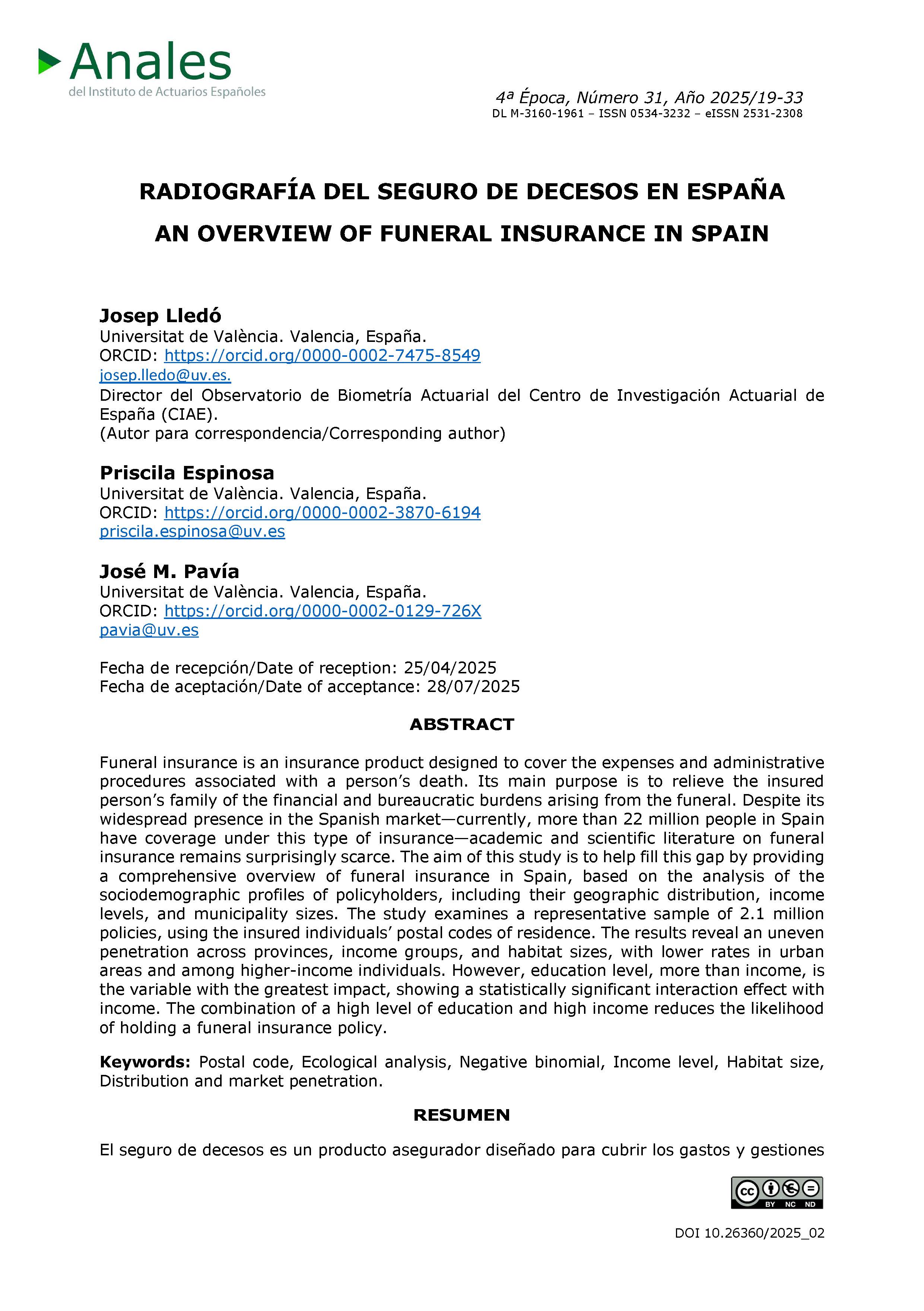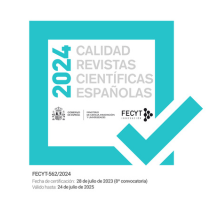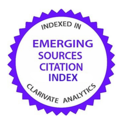An overview of funeral insurance in Spain
DOI:
https://doi.org/10.26360/2025_02Keywords:
postal code, ecological analysis, negative binomial, income level, habitat size, distribution, market penetrationAbstract
Funeral insurance is an insurance product designed to cover the expenses and administrative procedures associated with a person’s death. Its main purpose is to relieve the insured person’s family of the financial and bureaucratic burdens arising from the funeral. Despite its widespread presence in the Spanish market—currently, more than 22 million people in Spain have coverage under this type of insurance—academic and scientific literature on funeral insurance remains surprisingly scarce. The aim of this study is to help fill this gap by providing a comprehensive overview of funeral insurance in Spain, based on the analysis of the sociodemographic profiles of policyholders, including their geographic distribution, income levels, and municipality sizes. The study examines a representative sample of 2.1 million policies, using the insured individuals’ postal codes of residence. The results reveal an uneven penetration across provinces, income groups, and habitat sizes, with lower rates in urban areas and among higher-income individuals. However, education level, more than income, is the variable with the greatest impact, showing a statistically significant interaction effect with income. The combination of a high level of education and high income reduces the likelihood of holding a funeral insurance policy.
Downloads
References
Booth, J. G., Casella, G., Friedl, H., y Hobert, J. P. (2003). Negative binomial loglinear mixed models. Statistical Modelling. 3(3), 179-191. https://doi.org/10.1191/1471082X03st058oa
Cortés Martínez, F. J. (2004). Análisis global del seguro de decesos. Tesis del Master en Dirección de Entidades Aseguradoras y Financieras. Universitat de Barcelona.
Enroth, L., Jasilionis, D., Németh, L., Strand, B. H., Tanjung, I., Sundberg, L., Fors, S., Jylhä, M., y Brønnum-Hansen, H. (2022). Changes in socioeconomic differentials in old age life expectancy in four Nordic countries: the impact of educational expansion and education-specific mortality. European Journal of Ageing. 19(2), 161-173. https://doi.org/10.1007/s10433-022-00698-y
Gil, J. A., Heras, A., y Vilar, J. L. (1999). Matemática de los seguros de vida. Fundación MAPFRE.
Gutmann, M. P., Merchant, E. K., y Roberts, E. (2018). “Big Data” in Economic History. The Journal of Economic History. 78(1), 268–299. https://doi.org/10.1017/S0022050718000177
Hilbe, J. M. (2011). Negative Binomial Regression. Cambridge University Press.
Instituto Nacional de Estadística (2014). Clasificación Nacional de Educación 2014 (CNED-2014). http://bit.ly/4jPsed7
Instituto Nacional de Estadística (2024). Atlas de distribución de renta de los hogares (ADRH). Instituto Nacional de Estadística. https://goo.su/8RwpL
Goerlich, F. (2022). Elaboración de un mapa de Códigos Postales de España con recursos libres: cómo evitar pagar por disponer de información de referencia. IVIE working papers, 2022:03. https://doi.org/10.12842/WPIVIE_0322
Lledó, J., Pavía, J. M., y Espinosa, P. (2025). Impact of income level on life insurance pricing and reserving: evidence from Spain. Applied Economics Letters, 1–5. https://doi.org/10.1080/13504851.2025.2534509
Luy, M., Zannella, M., Wegner-Siegmundt, C., Minagawa, Y., Lutz, W., y Caselli, G. (2019). The impact of increasing education levels on rising life expectancy: a decomposition analysis for Italy, Denmark, and the USA. Genus. 75, 1-21.https://doi.org/10.1186/s41118-019-0055-0
Mazorra Rodríguez, A (2024). Social inequality and residential segregation trends in Spanish global cities. A comparative analysis of Madrid, Barcelona, and Valencia (2001-2021). Cities, 149, 104935. https://doi.org/10.1016/j.cities.2024.104935
Moreno, R., Gómez Pérez-Cacho, O., y Trigo, E. (2005). Matemática de los seguros de vida. Ediciones Pirámide.
Németh, L., Jasilionis, D., Brønnum-Hansen, H., y Jdanov, D. A. (2021). Method for reconstructing mortality by educational groups. Population Health Metrics. 19, 1-8. https://doi.org/10.1186/s12963-021-00264-1
Pavía, J. M., Lledó, J., Pérez Giménez, V., y Espinosa, P. (2025). Modelización espacial e intra-anual de la mortalidad en España. Una herramienta automática para el cálculo de productos de vida. Fundación MAPFRE. En prensa.
Pearl, J. (2009). Causality: Models, Reasoning and Inference. Cambridge University Press.
Pérez, V. y Pavía, JM. (2024). Automating the Transfer of Data between Census Sections and Postal Codes Areas Over Time. An application to Spain. Journal of Regional Research. En prensa. https://doi.org/10.38191/iirr-jorr.24.057
Pérez, V. y Pavía, J. M. (2025). sc2sc: Spatial Transfer of Statistics among Spanish Census Sections. Version 0.0.1-16. https://CRAN.R-project.org/package=sc2sc
Pérez-Miguel, E. y Trias-Llimós, S. (2025). Educational inequalities in cardiovascular mortality in Spanish regions (2016-2021). Gaceta sanitaria. 39, 102458. https://doi.org/10.1016/j.gaceta.2025.102458
Rius, D, y Torra, S. (2022). Aplicaciones actuariales mediante Gaussian Process Regression: Vida y No Vida. Anales del Instituto de Actuarios Españoles. 28, 67-100. https://doi.org/10.26360/2022_3
Ruggles, S. (2014). Big microdata for population research. Demography. 51, 287–297. https://doi.org/10.1007/s13524-013-0240-2
UNESPA. (2024). Seguro de decesos en España 2023. https://www.unespa.es/notasdeprensa/seguro-decesos-espana-2023

Downloads
Published
How to Cite
Issue
Section
License
Copyright (c) 2025 Josep Lledó Benito, Priscila Espinosa, Jose M. Pavía

This work is licensed under a Creative Commons Attribution-NonCommercial-NoDerivatives 4.0 International License.

















